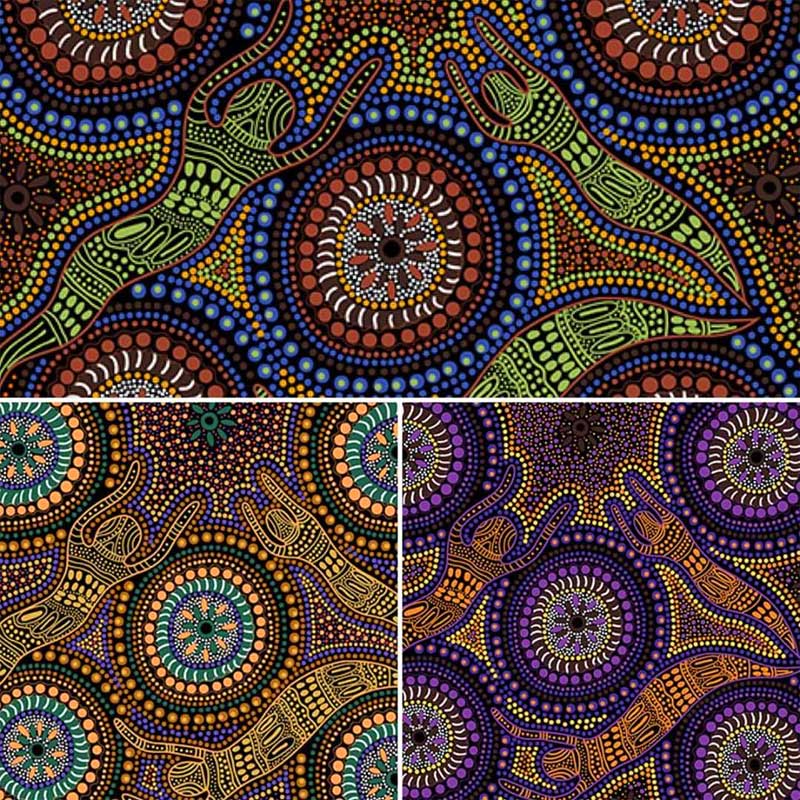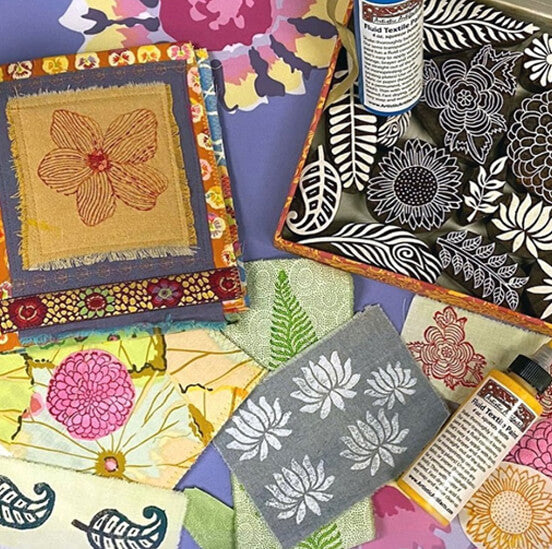Dreamtime Stories to Share
 In my last blog posting I wrote about visiting the Spring Quilt Market in St. Louis and gave you a taste of some of the beautiful fabrics and products exhibited there.
In my last blog posting I wrote about visiting the Spring Quilt Market in St. Louis and gave you a taste of some of the beautiful fabrics and products exhibited there.
One of my first stops, as always, was to see what was new from M&S Textiles (booth pictured here). Their Australian Aborigine-designed fabrics are consistently one of our biggest sellers, and I simply can’t resist them. The 2017 line of new designs has just arrived in our shop, and I’m sharing a few here. As we mentioned in our most recent newsletter, the Australia’s indigenous art tradition by Aborigines is more than 50,000 years old. In ancient times the Aboriginal people created cave paintings, rock paintings, and sand or ground painting, and more. We love to learn the stories behind these colorful patterned fabric designs and wanted to share some of them here.

M&S Textiles, the company that licenses these designs from the Aborigine artists and prints the high-quality cotton fabrics, shares that most of the Aboriginal designs have a “Dreamtime” story to tell. Aboriginal mythology recounts that Dreamtime is the time when the world was dark and nothing was on the earth. Soil was soft; then their forefathers sprang up from underneath it and began building most of what their future generations would require: mountains, rivers, waterholes, trees, light gardens and many more.
The Dreamtime is a philosophy of living. Body painting, corroborree (ceremonial gatherings of Aboriginal people where they interact with Dreamtime ancestors through dance, music, and costumes), men’s and women’s business (certain customs and practices are performed separately by male and female groups) are strictly obeyed by the Aboriginal people.
Aborigines used to be nomadic, collecting foods from nature by hunting and gathering. They never hoarded food or water, or spoiled nature, always honoring their ancestral lands and environment.
Bush Food Dreaming, pictured right, is a design by Tanya Price Nangala, available in (from top to bottom) black, ecru and mint. Tanya learned painting from both her parents and grandparents, and depicts a number of foods important to Aborigines: oranges, bush plums, bush berries, lemons and more. She is illustrating a corroboree where people are happily eating, dancing and discussing various social matters, enjoying each other’s company. Like many Aborigine artists, Tanya uses fine dotting techniques in the background of her precise, vibrant drawings.

Winter Spirits, pictured above, is designed by Fay Oliver. It is available in brown (top), yellow (left) and purple. The Sounthern hemisphere’s winter weather is hot and sunny like our northern hemisphere’s summer (in Australia each season begins on the first day of the calendar month: summer runs from December 1 to the end of February, autumn from March to May, winter from June to August, and spring from September to November). Fay uses vibrant winter colors to illustrate her painting, which depicts spirits watching over Dreamtime creatures, the bush and camp from the sky.

Pictured above is Sandy Creek by Janet Long Nakamarra, available in red (top), black and purple. Sandy Creek is located in the Northern Territory of Australia and is home to Tjaynera Falls, located within the Litchfield National Park. The Falls can only be reached by a 4-wheel drive vehicle and an approximately 1.4 kilometers from the car park, which is on the site of a timber cutting camp used during the mid 1900's. There are some Aboriginals who interact with tourists to the area, telling Dreamtime stories and involving them in timber-cutting activities. Janet is illustrating the plain land under the waterfall and some of the surrounding area. The semi-circles depict people walking the land as well as sitting in a circle around waterholes.
Artistic Artifacts is known for its large selection of Australian fabric, and these new designs are wonderful additions. We hope you have enjoyed learning more about the meaning behind the designs.







Leave a comment